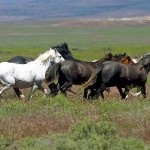July 29, 2010 – We keep hearing the upsetting stories from our wild horse advocates living in Nevada near the BLM wild horse holding facilities about wild horses being hauled in the middle of the night and disappearing. We hear it often.
We’ve been told by the Bureau of Land Management (BLM), that’s to prevent the horses from getting overheated during the high temperatures in the hot summer months, but that doesn’t fly when we hear of it happening during the cold winter months.
When numbers from BLM reports don’t add up, and large numbers of horses are missing from the charts, all those stories of night-time hauls come to mind.
Continue reading A Slick in the Night, by Valerie James-Patton
